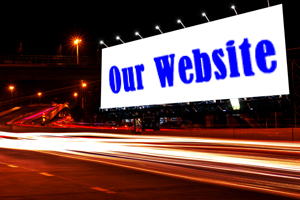
Today’s radio broadcasters are required to know how to use more tools than ever before. It’s no longer sufficient to simply know how the turntables and cart machines work; the modern radio DJ is expected to understand blogs, podcasts, social networks, email marketing, and more. To pull all of these different tools together into a single overarching framework, we use a Content Marketing strategy.
The first step in that Content Marketing strategy is to create content that is lives on your station’s website: online articles, blogposts, videos, podcasts, etc.
Once you’ve done that, you then need to drive people to that online content. Here are four channels for doing so:
1. Social Media
When you talk about online promotional channels, social networks like Facebook and Twitter are the first things that come to most radio broadcasters’ minds. You want to share your content on social media for the same reason that your radio station posts a billboard by the side of the highway: lots of people go there, and you hope some of them will see it and tune into your station — or click through to your website.
When it comes to social media, there are a lot of data points that can be measured, including likes, shares, and comments. Getting more of these is always a positive sign, but keep your focus on the most important data point: The number of people who click through and visit your website. After all, it is only once they come to your website that you can get them to take an action that has an impact on the bottom line.
Think of it this way: When you’re trying to measure the success of a billboard campaign, the yardstick you use is the Nielsen ratings. If they go up, the campaign worked. If they don’t go up, the campaign failed. It’s the same thing with social media: if your web traffic increases, your social media efforts are working; if it doesn’t, then you need to adjust.
This also means that some social networks are going to be more valuable than others. Lots of your listeners are on Instagram, but it’s much tougher to drive website traffic with Instagram than it is with Twitter because you can’t include clickable links in your Instagram posts. Meanwhile, Facebook’s ability to drive website traffic has significantly decreased for most broadcasters as the company has made changes to its algorithm.
2. Search Engines
 Unlike social media, most radio broadcasters pay very little attention to search engines. This is a mistake. You want your website content to appear in search engine results for the same reason you want your content on social media and you want your billboard by the highway: lots of people go to search engines. In my experience, social media traffic tends to be sporadic: a post can go viral on social media and attract a lot of traffic, then die down. With search engines, the traffic tends to be slow but steady. Once Google decides that a piece of content you created is a good match for a particular search query, it will continue to send people to your website day in and day out. Here’s an example of how one post has done that on our website.
Unlike social media, most radio broadcasters pay very little attention to search engines. This is a mistake. You want your website content to appear in search engine results for the same reason you want your content on social media and you want your billboard by the highway: lots of people go to search engines. In my experience, social media traffic tends to be sporadic: a post can go viral on social media and attract a lot of traffic, then die down. With search engines, the traffic tends to be slow but steady. Once Google decides that a piece of content you created is a good match for a particular search query, it will continue to send people to your website day in and day out. Here’s an example of how one post has done that on our website.
Search Engine Optimization (SEO) is the art of getting your content to appear in search engine results. It can be intimidating, and you could a firm to do SEO for your website if you felt the need, but there are some basic steps your station can take to optimize your website posts and increase the chances of them being found in search results.
3. Your Airwaves
Your station’s airwaves are the most potent weapon in its promotional arsenal. That’s why clients pay to be on them! Yet few radio stations take full advantage of this channel for driving traffic back to their website. I’m always surprised by the number of stations that run sweepers between songs to drive people to Facebook or Instagram, but not their own websites. If I were programming a radio station today, the production elements between every song would drive people back to a different page of the station website.
4. Email
 Email is not a good channel for driving people to your station’s website for the very first time (I don’t recommend buying email lists), but if people have given you their email address when they visited in the past, it’s a great way to drive return traffic. I recommend setting up automatic email campaigns that are sent to your list when you publish new content. Email is also a good way to recycle some of your older but evergreen content.
Email is not a good channel for driving people to your station’s website for the very first time (I don’t recommend buying email lists), but if people have given you their email address when they visited in the past, it’s a great way to drive return traffic. I recommend setting up automatic email campaigns that are sent to your list when you publish new content. Email is also a good way to recycle some of your older but evergreen content.
You will want to track the performance of all of these channels in your Google Analytics. You will also see other channels in your Google Analytics data, such as direct traffic (people who type your URL directly into their browser), referral traffic (people who come to your website by clicking on a link on another website, such as a blog), and paid search traffic (if you are paying to run a Google AdWords campaign). Over time, monitor how each of these channels are performing for you. You may discover some tweaks you can make to increase your website traffic.
More Digital Tips
- What Radio Broadcasters Need to Know About Facebook and Apple’s Podcasting Announcements
- A Checklist for Your Radio Station’s Big Event Webpage
- How to Reduce the Bounce Rate on Your Radio Station’s Website
- How to Repurpose Audio as Video to Promote Your Radio Station on Social Media
- If This Then That: the Website That Connects Your Online Tools
- A Simple Digital Treat to Thank Your Radio Listeners This Thanksgiving - November 13, 2023
- Interview Questions When Hiring Your Radio Station’s Next Digital Marketing Manager - November 6, 2023
- A Radio Conversation with ChatGPT: Part 2 – Promotions - October 30, 2023





Thank you for the tips. I am new to this and can use the help.